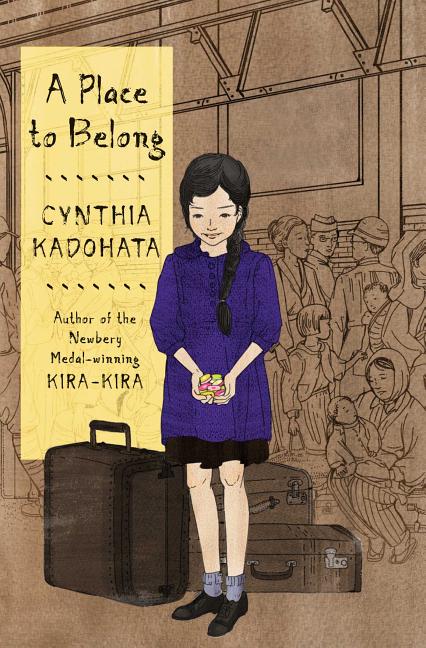Book Descriptions
for A Place to Belong by Cynthia Kadohata and Julia Kuo
From Cooperative Children's Book Center (CCBC)
In 1946, Hanako, 12, and her family arrive in Japan with others who, like her parents, refused to sign a loyalty oath while imprisoned in U.S. internment camps during World War II and are being deported. Their U.S. military ship lands near devastated Hiroshima. Her grandparents live in the countryside and are overjoyed to see their son and meet their daughter-in-law and grandchildren, but their spare survival is made more tenuous with Hana’s family to feed. It’s hard for Hana to refuse hungry people who knock at the door asking for food, although the adults tell her she must. How can she say no to someone who’s starving? But how can she give away food when her little brother, Akira, remembers imprisonment as a time when there was always enough to eat? While the adults work long days, Hana begins attending the village school, longing to feel less like an outsider. Then she faces startling news related to efforts to restore the civil rights of deported Japanese Americans. Hana’s deep feelings and probing thoughts, and singular, memorable characters propel a story that seamlessly weaves history and culture into an aching, beautiful tale of family and refugees and survival, one that also reflects realities playing out for so many children today. An author’s note provides additional information about the history surrounding the story’s events. (Ages 9–13)
CCBC Choices 2020. © Cooperative Children's Book Center, Univ. of Wisconsin - Madison, 2020. Used with permission.
From the Publisher
A Kirkus Reviews Best Middle Grade Book of 2019
A Japanese-American family, reeling from their ill treatment in the Japanese internment camps, gives up their American citizenship to move back to Hiroshima, unaware of the devastation wreaked by the atomic bomb in this piercing look at the aftermath of World War II by Newbery Medalist Cynthia Kadohata.
World War II has ended, but while America has won the war, twelve-year-old Hanako feels lost. To her, the world, and her world, seems irrevocably broken.
America, the only home she’s ever known, imprisoned then rejected her and her family—and thousands of other innocent Americans—because of their Japanese heritage, because Japan had bombed Pearl Harbor, Hawaii.
Japan, the country they’ve been forced to move to, the country they hope will be the family’s saving grace, where they were supposed to start new and better lives, is in shambles because America dropped bombs of their own—one on Hiroshima unlike any other in history. And Hanako’s grandparents live in a small village just outside the ravaged city.
The country is starving, the black markets run rampant, and countless orphans beg for food on the streets, but how can Hanako help them when there is not even enough food for her own brother?
Hanako feels she could crack under the pressure, but just because something is broken doesn’t mean it can’t be fixed. Cracks can make room for gold, her grandfather explains when he tells her about the tradition of kintsukuroi—fixing broken objects with gold lacquer, making them stronger and more beautiful than ever. As she struggles to adjust to find her place in a new world, Hanako will find that the gold can come in many forms, and family may be hers.
A Japanese-American family, reeling from their ill treatment in the Japanese internment camps, gives up their American citizenship to move back to Hiroshima, unaware of the devastation wreaked by the atomic bomb in this piercing look at the aftermath of World War II by Newbery Medalist Cynthia Kadohata.
World War II has ended, but while America has won the war, twelve-year-old Hanako feels lost. To her, the world, and her world, seems irrevocably broken.
America, the only home she’s ever known, imprisoned then rejected her and her family—and thousands of other innocent Americans—because of their Japanese heritage, because Japan had bombed Pearl Harbor, Hawaii.
Japan, the country they’ve been forced to move to, the country they hope will be the family’s saving grace, where they were supposed to start new and better lives, is in shambles because America dropped bombs of their own—one on Hiroshima unlike any other in history. And Hanako’s grandparents live in a small village just outside the ravaged city.
The country is starving, the black markets run rampant, and countless orphans beg for food on the streets, but how can Hanako help them when there is not even enough food for her own brother?
Hanako feels she could crack under the pressure, but just because something is broken doesn’t mean it can’t be fixed. Cracks can make room for gold, her grandfather explains when he tells her about the tradition of kintsukuroi—fixing broken objects with gold lacquer, making them stronger and more beautiful than ever. As she struggles to adjust to find her place in a new world, Hanako will find that the gold can come in many forms, and family may be hers.
Publisher description retrieved from Google Books.


